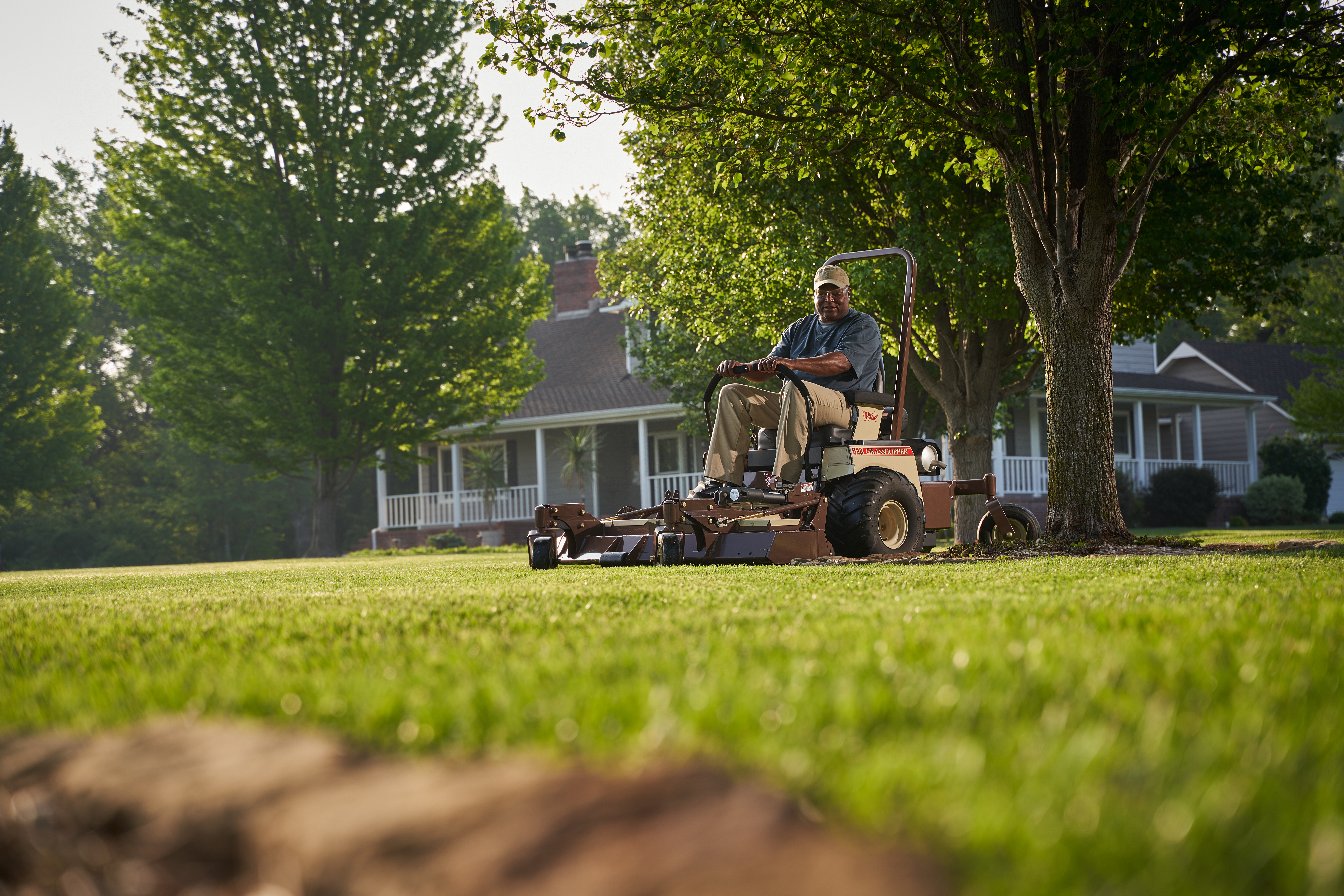Much like maintaining the proper tire pressure on a zero-turn mower, making sure the deck is level can have a huge impact on the finished result.
A properly leveled deck provides several benefits. Most importantly, it helps produce the uniform cut Grasshopper mowers are known for. Additionally, a level deck helps reduce wear and tear on the mower’s blades, spindles, belts and engine. A level deck also helps ensure that the blades can efficiently chop the grass clippings, which helps improve fuel efficiency.
If you’re noticing that things just aren’t looking as crisp and consistent after a crew has mowed, you might need to level the deck on the mower they’re using.
Check out the below step-by-step guide and demonstration video on how to level the deck on a Grasshopper MidMount™ mower. If you’re looking to learn how to level the deck on a different style of Grasshopper mower, click on the below links:
How to level the deck on your FrontMount™
How to level the deck on your OutStander® Stand-On
How to level a larger MidMount (335B)
The below instructions are unique to the 335B MidMount model, however most larger MidMounts are similar to each other. For exact instructions on your model, please contact your local Grasshopper dealer.
Step 1 – Park the mower on a hard, level surface. Remove the key and set the parking brake.
Step 2 – Check the rear tire pressure and adjust as necessary. Recommended PSI is noted on each tire’s rim. Also check the pressure in the front caster wheels. Recommended pressure is 12-15 PSI. Make sure both casters are identical and within this range.
Step 3 – Remove the side-discharge shield.
Step 4 – Set the deck to the mid-range of its cutting height.
Step 5 – Measure from the ground to the top of the deck shell on the operator’s right side. Repeat on the operator’s left side. Compare the two measurements to determine if you need to either raise or lower the left side of the deck.
Step 6 – Locate the front deck chain on the operator’s left side. This is where you’ll make the side-to-side adjustment.
Step 7 – Use a 5/8 wrench to hold the outside bolt head on the hanger chain bracket. On the inside of that bracket, use an 11/16 wrench to loosen the pass-thru bolt that holds the chain on.
Step 8 – Loosen the jam nut on the adjusting bolt. Now you can make adjustments to the bolt by tightening it or loosening it to either raise or lower that side of the deck.
Step 9 – After making adjustments to the left side of the deck, measure from the ground to the top of the deck shell on both sides of the mower. Compare the measurements to determine if additional adjustments are needed. Once both sides are the same, retighten all fasteners you have loosened.
Step 10 – Complete the deck-leveling process by leveling the front-to-back pitch. On the left-front side of the deck, measure from the ground to the top of the deck shell. Capture that same measurement at the left-rear of the deck. The front measurement should be 1/8” to 1/4" lower than the rear.
Step 11 – If a front-to-back adjustment is needed, identify the adjusting rods on each side of the deck. Loosen the back nut on each of the two adjusting rods.
Step 12 – On one side of the deck, tighten or loosen the front nut on the adjusting rod to raise or lower the rear of the deck as desired. Note that tightening raises the rear of the deck. Grab your tape measure to confirm that the front of the deck is 1/8” to 1/4" lower than the rear, and continue to adjust as needed.
Step 13 – Once that 1/8” to 1/4" pitch is confirmed, retighten the nuts on the adjusting rods to lock that pitch in.
Watch the above video for a detailed, step-by-step demonstration.
How to level a V Series MidMount (127V)
The below instructions are unique to the 127V MidMount model, however most smaller MidMounts are similar to each other. For exact instructions on your model, please contact your local Grasshopper dealer.
Step 1 – Park the mower on a hard, level surface. Remove the key and set the parking brake.
Step 2 – Check the tire pressure and adjust as necessary. Recommended PSI is noted on each tire’s rim. Also check the pressure in the front caster wheels. Recommended pressure is 12-15 PSI. Make sure both casters are identical and within this range.
Step 3 – Remove the side-discharge shield.
Step 4 – Set the deck to the mid-range of its cutting height.
Step 5 – On the operator’s left side, measure from the ground to the top of the deck shell. Repeat on the right side. Compare the two measurements to determine if an adjustment is needed to level the deck from side to side.
Step 6 – Locate the rear deck hanger chain on the operator’s right side. To access that chain, remove the fender by removing its front and rear bolts. Rest the fender on the drive tire.
Step 7 – Locate the adjusting bolt in the hanger chain mechanism; it’s the bolt that’s oriented vertically. Use a 5/8 wrench and an 11/16 wrench to loosen the clamp of the bolt to the bracket (oriented horizontally).
Step 8 – Loosen the locknut on the adjusting bolt. Then loosen or tighten the adjusting bolt as necessary. Note that tightening will lower the deck.
Step 9 – After making the necessary adjustments, measure from the ground to the top of the deck shell on the operator’s right side. Repeat on the left side. Compare the two measurements to determine if any further adjustments are needed.
Step 10 – Once the two measurements are the same and the deck is level from side to side, retighten all fasteners you have loosened.
Step 11 – Complete the deck-leveling process by leveling the front-to-back pitch. At the front of the deck on the operator’s left side, measure from the ground to the top of the deck shell. Capture the same measurement at the rear of the deck. The front measurement should be 1/8” to 1/4" lower than the rear.
Step 12 – If a pitch adjustment is needed, locate the front hanger chains on each side of the deck. Follow the same process described in Steps 7 and 8 to loosen or tighten the adjusting bolt as needed.
Step 13 – Once the desired front-to-back pitch is achieved, retighten all fasteners you have loosened. Also reinstall the fender that’s been resting on the drive tire since Step 6.
Watch the above video for a detailed, step-by-step demonstration.
As you can see, leveling the deck on your MidMount mower isn’t difficult at all. So the next time a freshly mowed lawn isn’t looking as even and manicured as usual, follow this process to make sure everything is in the proper alignment, so your mowing crews can stay on the right track.

.jpg)


